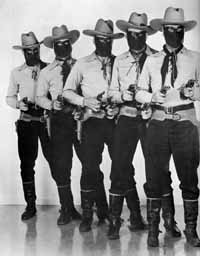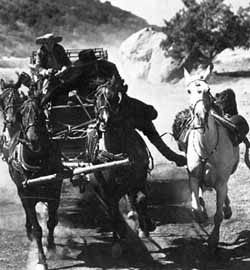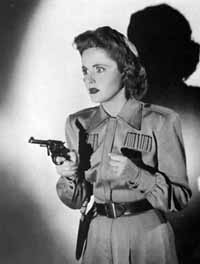|

Which one is the real Lone Ranger?
a publicity still for The Lone Ranger.
Witney and English first teamed on Zorro Rides Again (1937) with John Carroll in the title role and continued with The Lone Ranger (1938), possibly the most eagerly anticipated serial since Flash Gordon. Unlike so many serials that left us to guess at the identity of the villain behind the mask, The Lone Ranger left us to guess about the identify of the hero himself. The serial gave us five heroes of similar stature who all vied for the honor, leaving the audience to argue about the hero's identity. The wait took nearly 4 months, for only in the 15th chapter did the hero take off his mask.
Among the many serials handled by Witney and English, none is so surprising as Fighting Devil Dogs. With the second smallest budget in the history of Republic serials (a little over $100,000) and extensive use of stock footage from Dick Tracy and other serials, Fighting Devil Dogs emerged as one of the best serials ever made. With Lee Powell and Herman Brix as the heroes, Witney and English gave us a fast-paced story that moved from Southeast Asia to a South Pacific island to Southern California. We get military scenes with marines in the jungle, scenes in a submarine, scenes aboard a "flying wing," and scenes in the laboratory--in short, Fighting Devil Dogs gives us such a wide variety of scenes that the chapters never bog down under the weight of repetition (a frequent problem in serials). And to top it off, they gave us one of the great serial villains, the Lightning, a black-caped fiend with shiny black gloves and a sleek black helmet who used his electrical torpedoes to electrocute entire buildings. His torpedoes soared through the air, leaving a trail of sparks before detonating in a storm of lightning bolts.

Zorro prepares to overtake a stagecoach
in Zorro's Fighting Legion.
Witney and English covered a wide variety of serials in their tenure, including westerns (The Adventures of Red Ryder), a tale of the Canadian mounties (King of the Royal Mounted), super hero adventures (The Adventures of Captain Marvel), jungle adventures (Jungle Girl), detective thrillers (with three Dick Tracy serials), and crime serials with sci-fi overtones (Mysterious Dr. Satan). And even after their partnership dissolved they continued making fine serials separately, with Witney directing two of the all-time best serials, Spy Smasher and The Perils of Nyoka.
Meanwhile Universal cranked out two sequels to Flash Gordon, Flash Gordon's Trip to Mars (with Jean Rogers now a brunette, much to the disappointment of her admirers) and Flash Gordon Conquers the Universe (with Rogers replaced by Carol Hughes). In addition, Universal finally brought Buck Rogers to the big screen, with Buster Crabbe in the title role. Universal also gave us The Green Hornet, although most fans groaned when a standard late model sedan appeared instead of the radio show's souped up "Black Beauty."
Columbia faced a similar problem when they made Batman in 1943. Instead of creating the Batmobile, the filmmakers gave us a very ordinary looking sedan (and the Bat Plane, long a part of the comic book, was nowhere in sight). Most serial fans, deride Columbia serials, but before Sam Katzman took over serial production in the '40s, Columbia actually turned out a few decent efforts, such as The Spider's Web (1938), The Great Adventures of Wild Bill Hickock (1938), and The Shadow (1940). But Columbia never seemed comfortable with the serial format, frequently destroying the effect of cliffhangers by including several shots from the next week's episode--which clearly show the hero surviving. Without the illusion that the hero or heroine could be destroyed by the danger presented in the cliffhangers, their serials lacked a crucial part of the serial equation. How can we seriously consider the plight of the hero if we are given clear evidence that he'll be okay? This dunderheaded approach by Columbia betrayed their failure to understand the serial form.

Kay Aldridge as Nyoka
in a publicty still for Perils of Nyoka.
While throughout much of the history of the sound serial the heroine was relegated to supporting roles, in the early '40s, Republic reprised the serial heroine, as Frances Gifford starred in Edgar Rice Burroughs' Jungle Girl (1941) and Kay Aldridge starred in The Perils of Nyoka (1942). These serials gave us women who could keep pace with the men and throw some wicked punches of their own. They would occasionally have to be rescued by their male co-stars (Tom Neal in Jungle Girl and Clayton Moore in Perils of Nyoka), but in most cases they were perfectly capable of defending themselves. Jungle Girl, for example, could swing on vines and make high dives into jungle pools. Gifford had the beauty and charm to win over even the boys who swore that all girls had cooties. Unfortunately, however, she was on loan to Republic for Jungle Girl, and she wasn't available the next year when Republic planned Perils of Nyoka. Kay Aldridge made a capable heroine, but she was no Frances Gifford. Aldridge would subsequently appear in two more serials: Daredevils of the West (1943) with Allan Lane and Haunted Harbor (1944)with Kane Richmond. However, Linda Sterling would become the queen of the serial, starring in six serials during her reign, including The Tiger Woman (1944) and Manhunt of Mystery Island (1945). She looked and acted like the model she was, as she brought a refined elegance to her roles even when the roles asked for more earthy qualities. Her Tiger Woman, for example, was raised in the jungle since she was a child, but she has the manners of Emily Post.
At this point in the mid-'40s, an element of camp invaded the serials with the scenarios becoming increasingly silly and lazy with each week. Serials such as The Purple Monster Strikes even recycled the exact same camera shots for key scenes week after week. With such little respect for the audience, the serial started a slow decline, accompanied by scores of stock footage and legions of dull heroes.
page 4 of 5
 
The Serials: An Introduction
Page 1: In the Theaters
Page 2: The Beginnings
Page 3: Enter Flash Gordon
Page 4: The Golden Age
Page 5: The Downfall
The Phantom Empire
Flash Gordon
Dick Tracy
The Fighting Devil Dogs
Zorro's Fighting Legion
The Shadow
Mysterious Dr. Satan
Spy Smasher
Perils of Nyoka
The Tiger Woman
Serials Web Links
|






